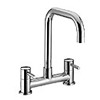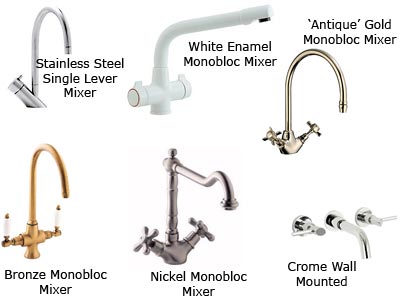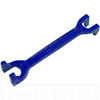Kitchen Taps
Introduction
There is an immense selection of kitchen taps available on the market today to satisfy all tastes and budgets and match any kitchen design scheme, this therefore means that the final choice simply comes down to aesthetic appearance and functionality. The following guide explains all the key variables to help you confidently select the right tap for your needs.
- Before diving straight to tap brochures, consider first the sink you have chosen for (or currently have in) your kitchen. Remember that if you’re fitting a new tap in an existing sink, or have purchased a sink with pre-drilled tap holes, you should choose a tap that requires the same number of holes to help simplify the installation. Also, a sink with more than one bowl will be best coupled with a mixer tap with a moveable spout.
Types of kitchen tap

Fundamentally there are three variables governing the design of taps;
- The number of faucets from which water flows.
- The number of holes that need to be made in the worktop, sink or wall.
- The number of valves controlling the flow of water.
Once you have decided your preference for each of these factors, the choice of tap becomes a more manageable proposition.
Tap styles and finishes
Nowadays, the range of options for kitchen taps in both contemporary and traditional designs is almost endless, and having chosen a style there is then the consideration of colour.
The majority of kitchen taps are fashioned in brass which can then be enamelled or metal plated with high gloss or matt finishes such as chrome, nickel, polished brass, pewter, silk steel and antique gold.
More expensive models are made of solid stainless steel, which can be polished to a high shine or brushed to create a low sheen finish. Although these are more expensive, they are more hard-wearing than their cheaper alternatives which will eventually lose their plated finish.

Water pressure requirements
Before selecting your tap, you should establish the level of water pressure you have in the kitchen. This is because many taps require high pressure to function correctly.
The cold water pressure is unlikely to be an issue as this should be delivered direct from the rising main at mains pressure (which should be about 2.0 bar). However, the hot water pressure must generally be above 1.0 bar if it is to supply a high pressure tap. If it is below this, you will only be able to drive a low pressure tap to function properly.
The hot water from your heating system (boiler) will be at high pressure if you have one of the following;
- An unvented (pressurised) system, wherein mains cold water directly supplies all cold taps and also travels direct to the hot water cylinder, keeping it at high pressure.
- A combination boiler, which is fed by the mains and heats hot water as you use it.
- A gravity fed system with a pump added to increase water pressure to more than 1.0 bar.
If you have an unpumped gravity-fed system, where the cold water tank is less than 10 metres above the tap, you should use a low pressure kitchen tap.
When using a mixer tap with a system that has a significant difference in cold and hot water pressure (ratio of 5:1), a pressure-reducing valve may need to be fitted to the cold supply to equalise the pressure. Thus, if mains cold water is supplied at 2.0 bar, the hot water must be supplied at no less than 0.4 bar (or cold water tank must be at least 4 metres above the tap) to avoid using a pressure-reducing valve.
- Generally speaking, single lever taps require high water pressure, while pillar taps and taps with two handles to control water flow can function with low pressure.
Fitting a kitchen tap

Although it's not necessarily the toughest plumbing challenge, some basic knowledge is still required to successfully fit a new kitchen tap. If you are in any doubt as to your abilities in this regard then always consult a professional plumber.
- Find a Plumber near you
Further information and useful links
- Find a Kitchen Sinks & Taps supplier near you
- Find a Kitchen Fitter near you
- Find a Kitchen Worktop supplier near you
- Find a Kitchen Fixtures & Fittings supplier near you
Site Pages
Featured Articles





